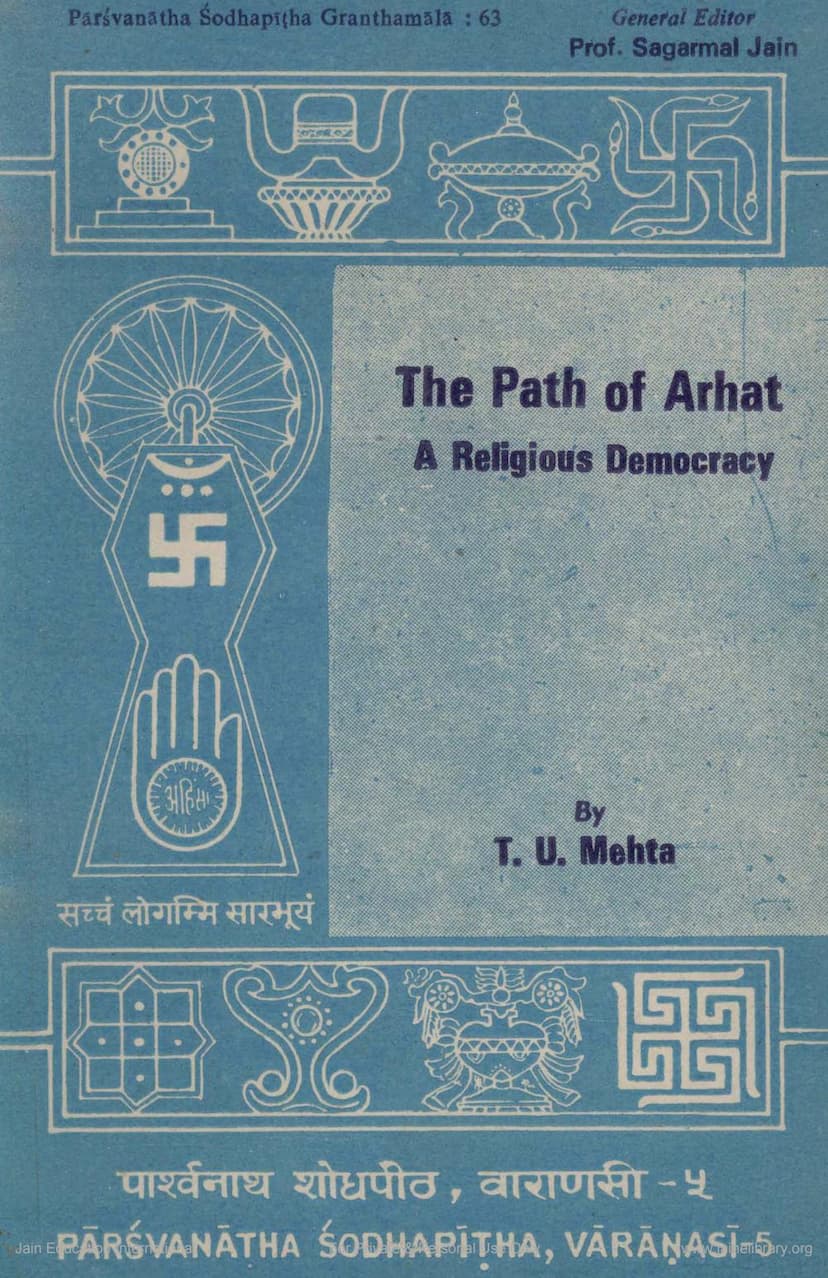Path Of Arhat
Added to library: September 2, 2025

Summary
Here's a comprehensive summary of "The Path of Arhat: A Religious Democracy" by T. U. Mehta, based on the provided text:
Overview:
"The Path of Arhat: A Religious Democracy" by T. U. Mehta, a retired Chief Justice, is a work aiming to explain the fundamental principles of Jainism in simple English. Published by Pujya Sohanalala Smaraka Parsvanatha Sodhapitha, it seeks to make Jain philosophy and ethics accessible to a broad audience, including those unfamiliar with Jain tradition and those living outside India. The book emphasizes Jainism's rationality, logic, and its relevance in the modern age.
Key Themes and Concepts:
- Jainism as a Rational Philosophy and Way of Life: The author stresses that Jainism is not merely an "ism" but a systematized line of thinking based on logic and reason. It doesn't demand allegiance to any individual or deity, but rather emphasizes self-effort and personal enlightenment.
- The Path of Arhat: An Arhat is defined as someone who has completely annihilated their internal enemies ("Ari" - enemy, "han" - to kill). This annihilation leads to liberation (Siddha) and ultimate freedom.
- Religious Democracy: The title highlights Jainism's emphasis on individual effort and the belief that liberation is accessible to all souls, regardless of their current state or background. It eschews hierarchical structures based on divine favor or external power.
- Origins and Synthesis: The book traces Jainism's origins, suggesting pre-Aryan roots and a significant Śramanic tradition that influenced Indian culture. It discusses the synthesis between Vedic and Śramanic traditions, highlighting the contributions of Tirthankaras like Rṣabha, Neminātha, and Pārśvanatha.
- Mahāvīra as a Non-Violent Revolutionary: Mahāvīra is presented as a key figure who rejuvenated existing Śramanic principles with a revolutionary zeal. His teachings emphasized equality, condemned caste distinctions, and promoted non-violence in thought, speech, and action. The book details his life, struggles, and significant events, including his association with Gośāla and the philosophical debates he engaged in.
- The Ultimate Reality and Ontology of Ātman (Self): Jainism posits that the universe is composed of two eternal and fundamental categories: Jiva (soul/consciousness) and Ajiva (matter/non-soul). Both are uncreated and operate through their inherent forces. The ultimate reality is within the self, which is pure consciousness, capable of achieving omniscience and bliss through its own efforts. The book refutes the concept of a creator God.
- Theory of Karma and Transmigration: Jainism's theory of Karma, which posits that actions (good or bad) lead to consequences and rebirths, is a central theme. This theory is presented as a rational explanation for the inequalities and complexities of life. The cycle of birth and rebirth (Samsara) is seen as the soul's journey towards liberation from karmic bondage.
- The Journey to Freedom (Moksha): This journey is achieved through the "Three Jewels" (Ratna-trayi): Samyag Darśana (Right Faith/Perception), Samyag Jñāna (Right Knowledge), and Samyag Caritra (Right Conduct). These are explained through the framework of Nine Tattvas (essences), including Jiva, Ajiva, Papa (sin), Punya (virtue), Asrava (influx of karma), Bandha (bondage), Samvara (prevention of karma influx), Nirjara (shedding of accumulated karma), and Moksha (liberation). The book also details the fourteen spiritual stages (Guna-sthanas) of this journey.
- Pluralistic Realism and Theory of Relativity (Nayavada and Syadvada): Jainism's unique contribution is the doctrine of Anekanta (many-sidedness) and Syadvada (relativity of judgment). These theories emphasize that reality is complex and can be viewed from multiple standpoints. Absolute judgments are cautioned against, promoting tolerance and understanding of differing perspectives. This is seen as a foundation for Ahimsa (non-violence) in thought.
- Pancasila (Five Principles of Right Conduct): The core ethical principles are Ahimsa (Non-violence), Satya (Truth), Asteya (Non-stealing), Brahmacarya (Chastity/Self-control), and Aparigraha (Non-possession/Limitation of desires). The book elaborates on the meaning and practice of each, emphasizing the importance of intention (Bhava) over mere external actions. Ahimsa is highlighted as the cornerstone, extending to thought and speech, and is seen as a weapon of the strong. Brahmacarya is discussed in its broader Indian context, encompassing control over mind, speech, and lifestyle. Aparigraha is presented as a solution to modern consumerism and societal unrest.
- Modus Operandi: The book outlines the practical methods for spiritual development, including the cultivation of objective observation, understanding cause and effect (Upadana-Nimitta), reflecting on twelve Bhavanas (reflections like Anitya - impermanence, Asarana - helplessness), adhering to minor vows (Anuvrata) and major vows (Mahavrata), and engaging in meditation (Dhyana) and austerities (Tapas).
- Dhyana and Lesya: Meditation is classified into four types: Artta (painful), Raudra (cruel), Dharma (righteous), and Sukla (pure). Sukla Dhyana is the highest form leading to liberation. Lesyas are described as mental dispositions reflected in one's aura and personality, with Sukla Lesya being the most auspicious.
- Comparison with Other Philosophies: The book includes appendices that briefly compare Jainism with Ajivika, Sankhya, and Buddhist philosophies, highlighting similarities and differences, particularly regarding the nature of the self, karma, and the path to liberation.
Overall Message:
"The Path of Arhat" argues that Jainism offers a rational, scientific, and psychologically grounded path to spiritual liberation. It advocates for personal responsibility, self-effort, and the development of inner virtues, leading to a life of peace, contentment, and universal understanding. The book aims to equip readers with the knowledge to appreciate Jainism's profound insights and its enduring relevance for navigating the complexities of life.